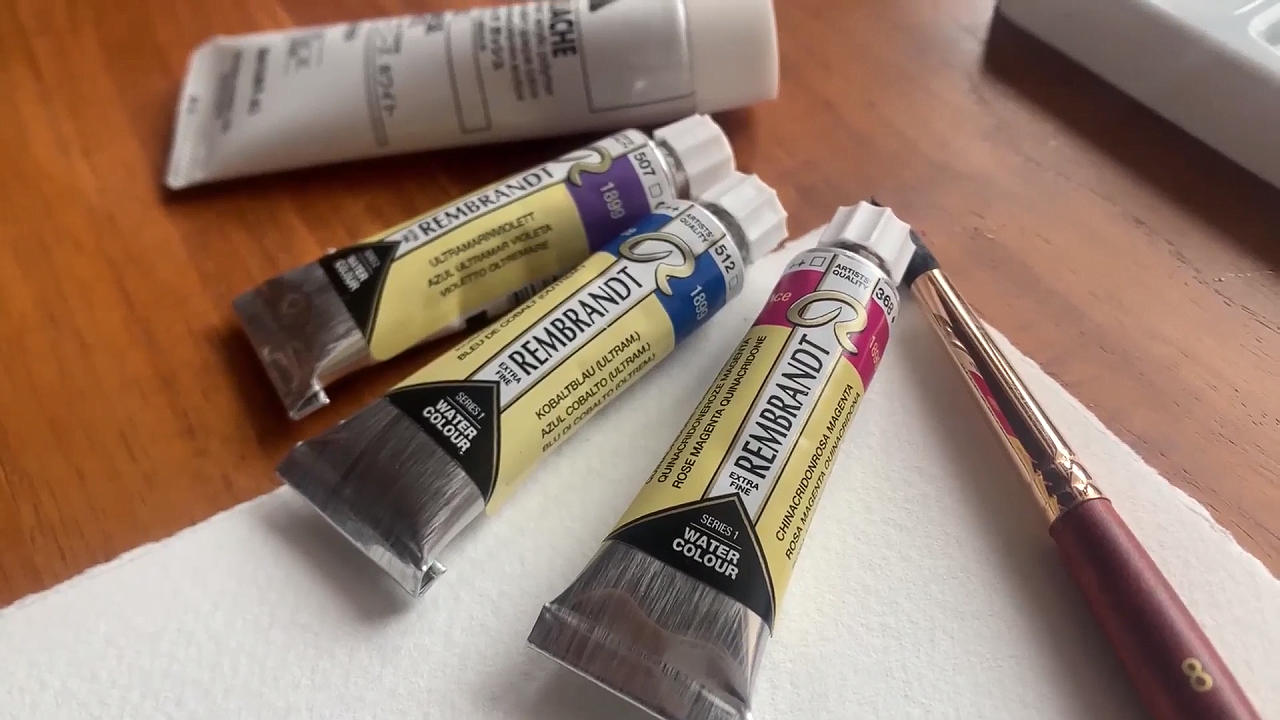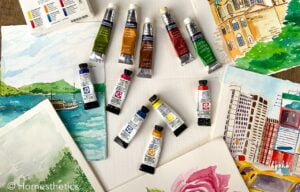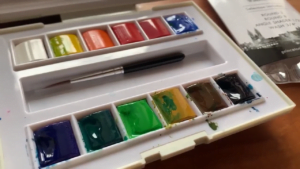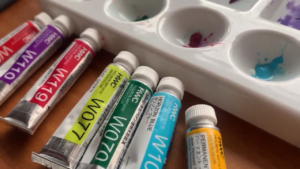Watercolor tubes are made using binders and pigment with a thick, cream-like consistency, while watercolor pans are available in the form of small cakes. Liquid watercolors contain highly concentrated pigment and watercolor pencils can be used for drawing and painting.

In the art world, few other types of paints can match the vibrancy and luminosity that watercolor paints offer.
That is the primary reason why such paints are the preferred choice for many artists. However, if you are just entering the world of watercolor painting, it can be quite confusing to distinguish between the different types of watercolors available.
That's why I've decided to share this guide on the subject.
How Is Watercolor Paint Manufactured?

To understand the differences between the various types of watercolor paints, it is vital to know how they are manufactured. While almost all types of watercolor paint essentially contain the same components and are manufactured similarly, the finished product can be quite different.
Generally, two primary ingredients are used to manufacture watercolor paints. These include gum arabic, which is the binding agent and color pigment that has been finely ground. In addition, there may be a moisturizer that prevents the binding agent from turning brittle and a wetting agent that allows the paint to flow on the painting surface.
Gum Arabic is a useful ingredient as a binder since it helps the paint to adhere to the canvas and allows you to use strokes with varying levels of transparency. Now that you know how watercolor paints are created, let's look at the different types of paints available.
Types Of Watercolor Paints
Watercolor paints can be categorized into six major types, and all other types of watercolor paints are generally derived from these.
1. Watercolor Tubes
Watercolor paint available in tubes has a cream-like consistency and is made using pigments and binders. Such paints may be available in a single tube or in sets of multiple tubes containing between three and five milliliters of paint.
The biggest advantage of these types of watercolor paints is that even a tiny tube contains a considerable amount of paint and can be used for large paintings. And you can mix different watercolor tube paints in a palette to create various colors.
Watercolor tube paint may be opaque, semi-transparent, or completely transparent but can retain its luminosity and vibrancy for a long period. The downside of using this type of watercolor paint is that it can dry out quickly if the cap of the tube is not sealed properly. Thankfully, most watercolor tube paints can be reused even after they have dried by adding a little water.
Daniel Smith is one of the most famous brands of watercolor tubes.
Pros
- Contain a considerable amount of paint
- Easier to find in single-color options
- Convenient to blend and use
- Can be dried as pans and reused later
Cons
- Slightly messy
2. Watercolor Pans
Manufactured in a manner similar to watercolor tubes, watercolor pans, also called watercolor cakes, are generally available in small containers. You can get them in full-pan or half-pan sizes, and both have a compact form, which makes them easily portable.
Like tube paints, watercolor pans are available in a single option and in sets of multiple colors. Watercolor pan sets may contain 12, 24, 36, or 48 colors and are available in extremely cheap and very pricey options.
Their special feature is that their pigment can last for an extended period, making them well-suited for all types of watercolor painting. You just need to apply some water to the paints to start using them. However, I would like to point out that the pigment present in watercolor pans is generally not as vibrant as that in tubes.
Pros
- Ideal for beginners
- Very compact and highly portable
- More affordable than liquid watercolors or tubes
- Easy to create new shades
Cons
- Can easily get dirty
3. Liquid Watercolors
Liquid watercolor paint is among the most vibrant options and can be diluted to reduce the vibrancy when needed by adding water. This type of paint can be manufactured using dyes or pigments and is usually available in bottles. For a single color, you can get a single bottle or get a set of liquid watercolor bottles for multiple colors.
What I like most about these paints in liquid form is that they can be used with a traditional brush as well as airbrush techniques. Liquid paint also flows quite well, which is why it is the most suitable option for kids, but you can even find artist-grade paint in this segment.
On the downside, these paints are not the best when it comes to lightfastness, which is why the paint cannot resist fading when exposed to light. Thus, artworks created using this type of watercolor paint can fade with time.
Pros
- Highly concentrated pigments lead to vibrant colors
- Tend to last a long time
- Well-suited for detailed work and lettering
- Do not require adding water
Cons
- Can fade quickly in the sun
4. Watercolor Pencils
Watercolor pencils are a great choice for students, hobbyists, professionals, and artists since they offer the advantages of drawing and painting with a single tool. This type of watercolor paint is available in the form of pencils, but instead of a graphite core, the pencils have a core made of color pigments.
When dry, these pencils can be used for drawing like regular ones. But you can activate the pigment by dabbing the tip in water to give your artwork a watercolor feel. These pencils do not require as much water as other types of paint and are easy to carry around.
Watercolor pencils used by students are generally available at affordable prices, but professional-grade ones can be costly. While these types of watercolor paint offer greater control, they do not retain their vibrancy after drying, much like watercolor pans.
Pros
- Can be used with other watercolor paints
- Suitable for drawing, sketching, and painting
- Available in student and artist grades
- Easy to use
Cons
- Poor lightfastness rating
5. Watercolor Markers
Watercolor markers are similar to regular markers but contain water-soluble ink. You can use them as standard markers or for watercolor painting by adding water that helps dilute the ink pigment. These markers are available in a wide selection of colors and usually have a brush tip on one end and a bullet tip on the other.
The tips are the most useful feature and are made of nylon, which makes them quite flexible and incredibly versatile. You can use the bullet-type tip for painting one section and the brush tip for another.
Bullet tips are similar to the tips on standard markers, while brush tips move more smoothly over the painting surface, just like a paintbrush. But the watercolor markers do not have a very good lightfastness rating, and their vibrancy depends on the solubility of the pigment. Also, compared to other types of watercolor paints, watercolor markers do not last very long.
Pros
- Two different tip types
- Convenient to use
- Versatile
- Ideal for beginners
Cons
- Not the best for very large paintings
6. Gouache Paints
Unlike most other types of watercolor paints, gouache paint is a non-transparent option, resulting in punchier and more vibrant colors. It can be activated by the application of water and is easier to use than oil-based paint. Artworks done using this type of watercolor paint have a chalky, matte-type finish.
The major advantage of gouache is that it is easier to work with than many other types of watercolor paints. You can use other types of watercolor, such as colored pencils, over these paints once they are dry. And there is no need to follow any specific order when painting due to the non-transparent nature of gouache paint.
Additionally, gouache paint can be easily lifted off a surface for alterations or adjustments. But this type of watercolor paint works best on paper that is already wet and may not be ideal when you require a transparent medium.
Sennelier, owned by Blick, is a leading manufacturer of gouache and other watercolor paints.
Pros
- Allows making alterations and adjustments
- Contains strong, vibrant pigments
- Dries quickly
- Easy to blend
Cons
- Can get muddy quickly

Best Watercolor Paints
Now that you know about the different types of watercolor paints, let's look at some of the best options.
1. ARTEZA Watercolor Paint - Watercolor Tubes
- Rich Watercolor Paint Set: Unleash your creativity with...
- Paint Conservation Made Easy: Our watercolor paint tubes...
The Arteza brand is known for its range of high-quality art supplies, and this watercolor paint is an excellent option when it comes to watercolor tubes. Made from the best quality pigment, these tube paints are available in a single tube option or packs that can contain 24 or 60 tubes.
Each tube has lightfastness and transparency indicators to provide all the information regarding the paint. You get 12 ml of paint in the tubes that are easy to squeeze and have a convenient screw cap to prevent the paint from drying. The colors are also quite vivid and support multiple painting techniques, like glazing, wash painting and dry brush painting.
You can use these tube colors with other supplies, like colored watercolor pencils, and they come in a box for easy storage. Since these watercolor tube paints are non-toxic, they are an ideal choice for kids, hobbyists, and professionals.
2. Winsor And Newton Cotman Watercolor Paint - Watercolor Pans
- Winsor & Newton Cotman Water Colours are a range of water...
- Cotman Water Colours possess good transparency, excellent...
These watercolor pans from Winsor and Newton are available in a set of 13 colors and have a high level of transparency for different types of artwork. They come in a plastic storage box with a mixing palette in the lid that can be quite handy when painting. There is also a brush tray that can be used for techniques like graded washes.
The pigments used in these watercolor pans come from various sources, including natural and synthetic ones. And I liked that the consistency of these pigments does not change between different colors, making them especially useful for beginners.
Despite being high-quality watercolor pans, they are one of the most affordable options. The color selection is also nice, and the compact size of the box makes the Winsor & Newton watercolor pans great as far as portability is concerned.
3. S & S Worldwide Liquid Watercolor Paint - Liquid Watercolors
- BEAUTIFUL, VIBRANT COLORS: A set of six 1-oz. bottles with...
- MORE VERSATILE THAN SOLID WATERCOLORS: Can be used as color...
If you're looking for liquid watercolor paint, this option from S & S Worldwide which contains six vibrant colors, might be worth considering. These incredibly versatile colors can be mixed together to create new shades for use on various surfaces. You can apply them on watercolor paper, wood, glass, fabrics, and more.
Since these are liquid watercolors, you can use different tools for application, such as an eye dropper, watercolor brush, or spray bottle. The colors are water-based and completely non-toxic, making them suitable for adults and kids. Color saturation is also impressive, and the bottles come in a small box for easy storage.
Moreover, the S & S Worldwide liquid watercolors are a budget-friendly option, so you won't need to break the bank to get excellent painting results. They are easy to use without requiring a lot of skill, thus making them a good option for those just starting out.
4. Zenacolor Watercolor Pencils - Watercolor Pencils
- 72 WATERCOLOR PENCILS AND BRUSH - Our set of 72 watercolor...
- FINE, PRECISE, AND WATER-SOLUBLE LEAD - Our watercolor...
Zenacolor is a brand that specializes in manufacturing premium art supplies, specifically colored pencils, and these watercolor pencils are among the finest offerings from the brand. It is a set of 72 watercolor pencils that come with pre-sharpened tips and a back brush. Each pencil has a 3.3 mm lead that is sturdy but soft enough for easy painting.
These are a versatile option that can be used for drawing, sketches, shading, art therapy, etc. With these pencils, you can use a moist paintbrush to mix, blend, and combine different colors easily. There is also a metal storage case that makes it easy to store the pencils and carry them where required.
What I like most about these watercolor pencils is that they come with a 30-day money-back satisfaction guarantee. If you are not happy with their performance, the seller promises to provide a complete refund.
5. ARTEZA Watercolor Markers - Watercolor Markers
- Premium Quality Watercolor Pens: Our brush pens come in a...
- Multiple Creative Uses Paint Brush Pens: Whether you want to...
As far as watercolor markers go, these markers from ARTEZA are among the finest and come with fantastic features like self-cleaning bristles. These bristles are made from nylon, which makes them very durable, and allows you to use them for blending without needing to clean them afterward.
You can use these pens for illustrations, drawings, sketches, and even calligraphy. The colors are water-based and do not bleed, making the painting experience smoother and more enjoyable. Additionally, the ink of the markers dries quickly and permanently, which further adds to the experience.
Being non-toxic, these watercolor markers are suitable for people of all age groups and are also mess-free, meaning you do not have to spend much time cleaning up after painting. The markers come in sturdy cardboard packaging that can be used for storage, while they have ergonomically designed barrels for comfortable use.
6. Artme Gouache Paint Set - Gouache Paints
- 24 LASTING VIBRANT COLORS: each color has 30 ml large...
- HIGH-QUALITY PAINT BRUSHES: Highly durable brushes, 2 flat...
The Artme Gouache paints are available in 24 colors, each containing 30 ml of pigment. The paints have a thick consistency that can help retain spatula or brush marks and provide texture to your paintings. You also get a set of high-quality paint brushes with these paints, which are highly durable.
There is one round-tip brush and two flat-tip brushes specially designed for gouache painting. The colors can be used for large sections as well as detailing with exceptional results. I also liked the box these paints come in, which has been designed to keep the paints moist and ready for use.
Other than that, the paints do not crack or crumble even after drying and can be diluted by adding a little water. The most important feature of the Artme Gouache Paint Set is that it meets the U.S. ASTM D-4236 & EU EN71 safety standards and is completely non-toxic.
Buying Guide - How To Choose The Right Watercolor Paints?
Selecting between the different types of watercolor paints isn't easy, especially if you are a beginner and have no experience. But various types of paints available can affect the painting process and the finished artwork in different ways. That is why it is crucial to select paints that you find easy to use and suitable for the specific artwork.
In this section, I've mentioned some of the things worth considering that can make it easier for you to select the right type of watercolor paint.
1. Quality
Like acrylic paints, watercolor paints can be divided into two categories - student and artist grades. Student-grade paint contains a larger quantity of binders and less pigment, which is why it tends to be cheaper. Artist-grade watercolor paint contains a larger amount of high-quality pigment.
The paint quality you should select will depend on your painting requirements and budget. For those with professional requirements, artist-grade watercolors are a better choice, while hobbyists and beginners can go with student-grade options. The biggest difference between the two is that artist-grade paints will last much longer, so they are better for studio artists.
2. Color Selection
Various manufacturers and brands offer different color selections, and the colors available are another consideration when selecting watercolor paints. This is because getting every color available is not practically feasible, but having a set of versatile colors that can meet most requirements is essential.
Some common colors that are often needed include sky color, umber, honey, ultramarine, etc. You can also create other colors by mixing all primary color paints. When starting out, go with a few select colors that can be later expanded as required.
Getting a set of colors or individual colors are both good options, but keep in mind that not all types of watercolor paints may be available in individual colors.
3. Lightfastness
The lightfastness of a color refers to its ability to withstand exposure to factors like light and humidity without any alteration in its vibrancy. Watercolor paints generally have a lightfastness rating that ranges from one to four. Paints having a lightfastness rating of one are considered to be the best since they are not affected by light and can last a long time.
On the other hand, paints with a rating of four can easily fade or darken on exposure to light. Paintings done using these colors need to be kept away from sunlight. The rating is mentioned on the packaging or the manufacturer's website and may sometimes be mentioned as excellent or very good.
4. Transparency And Translucency
What makes watercolor paints different from other types is their transparency. Watercolors allow light to pass through them and bounce back from the surface of the paper, making the artwork extremely vibrant. However, the transparency of watercolor paints often depends on the type of paint.
For instance, liquid watercolors, tubes, and pans are the most transparent, while watercolor pencils and markers may be semi-transparent or translucent. Finally, gouache colors are opaque, and their higher opacity makes them more suitable if you want to create a painting with a matte-like texture.
While some artists avoid using opaque watercolor paints, it should not be a problem for hobbyists and beginners. The only thing to remember is that transparency will affect the layering process, and more transparent colors will allow all the different colors to show through.
5. Staining And Non-Staining
Certain types of watercolor paints tend to pass through the fibers of the paper or other painting surfaces, leading to staining, while others remain on the surface even after drying. The latter can be easily removed for adjustments. Usually, the distinction between staining and non-staining is not a major cause of concern for home use.
However, if you are going to be trying out lifting or layering techniques, it is important to select colors that allow doing so. Such techniques often require removing paint from certain parts of the painting, which is only possible if the colors are non-staining and easily removable.
6. Brands
Various characteristics, such as quality, lightfastness, transparency, etc., can vary significantly between watercolor paints from different brands. While paints from a particular brand may be better in one aspect, they may be worse in another than paints from another brand.
You can experiment and select various colors from different brands. However, remember that colors from reputable brands may be better than those from relatively unknown ones, though there can be exceptions. Ultimately, in this case, personal preference is a major factor when choosing the right type of watercolor paint.
7. Budget
Since watercolor paints are available at different price points, ranging from extremely expensive to very affordable ones, you need to consider your budget when deciding. For those just wanting to experiment with watercolors or starting out, I wouldn't suggest spending a large amount of money when getting watercolors.
Once you gain experience and get used to watercolor painting, you can upgrade to costlier options. However, when it comes to professional requirements, spending more and getting better quality paints is better than going with inferior quality ones that may not cost much.
That being said, it isn't necessary that cheaper paints will always be of better quality and vice versa. You can try checking the prices at online stores like Amazon when deciding.
While there are several options to choose from, for beginners, I would recommend going with half-pan watercolors. They are much easier to use than most other types of watercolor paints and quite inexpensive. These paints allow you to try out various techniques and experiment freely. Once you’ve mastered the basics of watercolor painting, you can upgrade to other options. Watercolor paints do not expire, but their quality can deteriorate with time, especially if not stored properly. The pigment in the paints can separate from the binding agents, making it impossible to moisten the paint again. Surprisingly, watercolor paints that have been taken out in a palette can last a bit longer if stored properly. The period for which watercolors can last vary among the different types of paints. For instance, watercolor markers can last around two years, while watercolor tube paints can last up to five years. Similarly, pan watercolor paints can last as long as ten years, and watercolor pencils can last indefinitely. For tube watercolors, always make sure to tighten the caps of the tubes properly. You can also keep tube colors in airtight jars to protect them from moisture. For pan watercolors, ensure the colors are dry before closing the container lid to prevent them from getting muddy. Similarly, liquid watercolors can be kept in small containers, such as condiment or food jars. Fugitive watercolor paints are those whose colors can alter depending on changes in certain environmental factors, such as temperature, light, and humidity. Thus, these colors do not have a permanent nature and can become lighter or darker, or their hue may change or completely fade away when exposed to certain conditions. Types Of Watercolor Paints Related FAQs
Tip
When selecting watercolor paints, avoid options containing elements like antimony, cadmium, barium, chrome, lead, zinc, etc. Prolonged exposure to elements like cadmium pigments can cause poisoning. To avoid paint toxicity, look for safer alternatives that meet ASTM International standards.

Conclusion
Whether you are a beginner, an intermediate user, hobbyist, or a professional artist, selecting the right type of watercolor paint is crucial. It can determine not only the quality of the artwork but also the painting process and your painting experience.
With the information provided here in this guide, you may now have some idea regarding the different types of paints available and which one to choose. Just keep your personal requirements in mind, as nothing is more important, and consider the factors mentioned in the buying guide before making a decision.
Doing so will make it easy to find the most suitable watercolor paints from among the various options.
Related Articles






